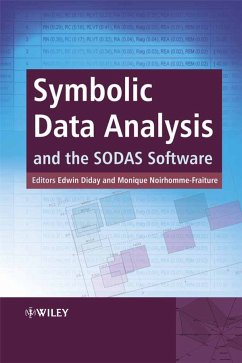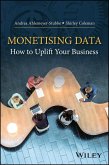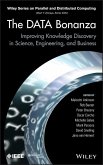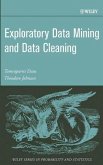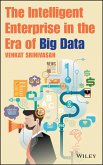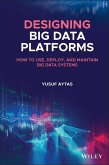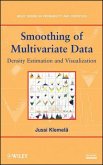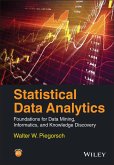Symbolic Data Analysis and the SODAS Software (eBook, PDF)
Redaktion: Diday, Edwin; Noirhomme-Fraiture, Monique
145,99 €
145,99 €
inkl. MwSt.
Sofort per Download lieferbar

0 °P sammeln
145,99 €
Als Download kaufen

145,99 €
inkl. MwSt.
Sofort per Download lieferbar

0 °P sammeln
Jetzt verschenken
Alle Infos zum eBook verschenken
145,99 €
inkl. MwSt.
Sofort per Download lieferbar
Alle Infos zum eBook verschenken

0 °P sammeln
Symbolic Data Analysis and the SODAS Software (eBook, PDF)
Redaktion: Diday, Edwin; Noirhomme-Fraiture, Monique
- Format: PDF
- Merkliste
- Auf die Merkliste
- Bewerten Bewerten
- Teilen
- Produkt teilen
- Produkterinnerung
- Produkterinnerung

Bitte loggen Sie sich zunächst in Ihr Kundenkonto ein oder registrieren Sie sich bei
bücher.de, um das eBook-Abo tolino select nutzen zu können.
Hier können Sie sich einloggen
Hier können Sie sich einloggen
Sie sind bereits eingeloggt. Klicken Sie auf 2. tolino select Abo, um fortzufahren.

Bitte loggen Sie sich zunächst in Ihr Kundenkonto ein oder registrieren Sie sich bei bücher.de, um das eBook-Abo tolino select nutzen zu können.
Symbolic data analysis is a relatively new field that provides a range of methods for analyzing complex datasets. Standard statistical methods do not have the power or flexibility to make sense of very large datasets, and symbolic data analysis techniques have been developed in order to extract knowledge from such data. Symbolic data methods differ from that of data mining, for example, because rather than identifying points of interest in the data, symbolic data methods allow the user to build models of the data and make predictions about future events. This book is the result of the work f a…mehr
- Geräte: PC
- mit Kopierschutz
- eBook Hilfe
Andere Kunden interessierten sich auch für
![Monetizing Data (eBook, PDF) Monetizing Data (eBook, PDF)]() Andrea Ahlemeyer-StubbeMonetizing Data (eBook, PDF)58,99 €
Andrea Ahlemeyer-StubbeMonetizing Data (eBook, PDF)58,99 €![The Data Bonanza (eBook, PDF) The Data Bonanza (eBook, PDF)]() The Data Bonanza (eBook, PDF)99,99 €
The Data Bonanza (eBook, PDF)99,99 €![Exploratory Data Mining and Data Cleaning (eBook, PDF) Exploratory Data Mining and Data Cleaning (eBook, PDF)]() Tamraparni DasuExploratory Data Mining and Data Cleaning (eBook, PDF)131,99 €
Tamraparni DasuExploratory Data Mining and Data Cleaning (eBook, PDF)131,99 €![The Intelligent Enterprise in the Era of Big Data (eBook, PDF) The Intelligent Enterprise in the Era of Big Data (eBook, PDF)]() Venkat SrinivasanThe Intelligent Enterprise in the Era of Big Data (eBook, PDF)35,99 €
Venkat SrinivasanThe Intelligent Enterprise in the Era of Big Data (eBook, PDF)35,99 €![Designing Big Data Platforms (eBook, PDF) Designing Big Data Platforms (eBook, PDF)]() Yusuf AytasDesigning Big Data Platforms (eBook, PDF)114,99 €
Yusuf AytasDesigning Big Data Platforms (eBook, PDF)114,99 €![Smoothing of Multivariate Data (eBook, PDF) Smoothing of Multivariate Data (eBook, PDF)]() Jussi KlemeläSmoothing of Multivariate Data (eBook, PDF)138,99 €
Jussi KlemeläSmoothing of Multivariate Data (eBook, PDF)138,99 €![Statistical Data Analytics (eBook, PDF) Statistical Data Analytics (eBook, PDF)]() Walter W. PiegorschStatistical Data Analytics (eBook, PDF)83,99 €
Walter W. PiegorschStatistical Data Analytics (eBook, PDF)83,99 €-
-
-
Symbolic data analysis is a relatively new field that provides a range of methods for analyzing complex datasets. Standard statistical methods do not have the power or flexibility to make sense of very large datasets, and symbolic data analysis techniques have been developed in order to extract knowledge from such data. Symbolic data methods differ from that of data mining, for example, because rather than identifying points of interest in the data, symbolic data methods allow the user to build models of the data and make predictions about future events. This book is the result of the work f a pan-European project team led by Edwin Diday following 3 years work sponsored by EUROSTAT. It includes a full explanation of the new SODAS software developed as a result of this project. The software and methods described highlight the crossover between statistics and computer science, with a particular emphasis on data mining.
Dieser Download kann aus rechtlichen Gründen nur mit Rechnungsadresse in D ausgeliefert werden.
Produktdetails
- Produktdetails
- Verlag: John Wiley & Sons
- Erscheinungstermin: 15. April 2008
- Englisch
- ISBN-13: 9780470723555
- Artikelnr.: 37298706
- Verlag: John Wiley & Sons
- Erscheinungstermin: 15. April 2008
- Englisch
- ISBN-13: 9780470723555
- Artikelnr.: 37298706
- Herstellerkennzeichnung Die Herstellerinformationen sind derzeit nicht verfügbar.
Edwin Diday, Centre De Recherche en Mathématiques de la Décision, Université Paris 9, France Edwin is a Professor of Computer Science, with 50 published papers, and 14 authored or edited books to his name. He has led international research teams in Symbolic Data Analysis, and is the founder of the field. M. Noirhomme-Fraiture, Institute of Computer Science, University of Namur, Belgium Monique Noirhomme-Fraiture is Professor and Head of the Unit of Applied Mathematics at the above faculty. She is involved in several HCI projects as well as having organized conferences and workshops within this field. She has contributed to 28 published papers and co-authored 2 books.
Contributors.
Foreword.
Preface.
ASSO Partners.
Introduction.
1. The state of the art in symbolic data analysis: overview and future
(Edwin Diday).
PART I. DATABASES VERSUS SYMBOLIC OBJECTS.
2. Improved generation of symbolic objects from relational databases (Yves
Lechevallier, Aicha El Golli and George Hébrail).
3. Exporting symbolic objects to databases (Donato Malerba, Floriana
Esposito and Annalisa Appice).
4. A statistical metadata model for symbolic objects (Haralambos
Papageorgiou and Maria Vardaki).
5. Editing symbolic data (Monique-Noirhomme-Fraiture, Paula Brito, Anne de
Baenst-Vandenbroucke and Adolphe Nahimana).
6. The normal symbolic form (Marc Csernel and Francisco de A.T. de
Carvalho).
7. Visualization (Monique-Noirhomme-Fraiture and Adolphe Nahimana).
PART II. UNSUPERVISED METHODS.
8. Dissimilarity and matching (Floriana Esposito, Donato Malerba and
Annalisa Appice).
9. Unsupervised divisive classification (Jean-Paul Rasson, Jean-Yves
Pirçon, Pascale Lallemand and Séverine Adans).
10. Hierarchical and pyramidal clustering (Paula Brito and Francisco de
A.T. de Carvalho).
11 .Clustering methods in symbolic data analysis (Francisco de A.T. de
Carvalho, Yves Lechevallier and Rosanna Verde).
12. Visualizing symbolic data by Kohonen maps (Hans-Hermann Bock).
13 .Validation of clustering structure: determination of the number of
clusters (André Hardy).
14. Stability measures for assessing a partition and its clusters:
application to symbolic data sets (Patrice Bertrand and Ghazi Bel Mufti).
15. Principal component analysis of symbolic data described by intervals
(N.Carlo Lauro, Rosanna Verde and Antonio Irpino).
16. Generalized canonical analysis (N.Carlo Lauro, Rosanna Verde and
Antonio Irpino).
PART III .SUPERVISED METHODS.
17. Bayesian decision trees (Jean-Paul Rasson, Pascale Lallemand and
Séverine Adans).
18. Factor discriminant analysis (N.Carlo Lauro, Rosanna Verde and Antonio
Irpino).
19. Symbolic linear regression methodology (Filipe Afonso, Lynne Billard,
Edwin Diday and Mehdi Limam).
20. Multi-layer perceptrons and symbolic data (Fabrice Rossi and Brieuc
Conan-Guez).
PART IV. APPLICATION AND THE SODAS SOFTWARE.
21. Application to the Finnish, Spanish and Portuguese data of the European
Social Survey (Soile Mustjärvi and Seppo Laaksonen).
22. People's life values and trust components in Europe: symbolic data
analysis for 20-22 countries (Seppo Laaksonen).
23. Symbolic analysis of the Time Use Survey in the Basque country (Marta
Mas and Haritz Olaeta).
24. SODAS2 software: overview and methodology (Anne de Baenst-Vandenbroucke
and Yves Lechevallier).
Index.
Foreword.
Preface.
ASSO Partners.
Introduction.
1. The state of the art in symbolic data analysis: overview and future
(Edwin Diday).
PART I. DATABASES VERSUS SYMBOLIC OBJECTS.
2. Improved generation of symbolic objects from relational databases (Yves
Lechevallier, Aicha El Golli and George Hébrail).
3. Exporting symbolic objects to databases (Donato Malerba, Floriana
Esposito and Annalisa Appice).
4. A statistical metadata model for symbolic objects (Haralambos
Papageorgiou and Maria Vardaki).
5. Editing symbolic data (Monique-Noirhomme-Fraiture, Paula Brito, Anne de
Baenst-Vandenbroucke and Adolphe Nahimana).
6. The normal symbolic form (Marc Csernel and Francisco de A.T. de
Carvalho).
7. Visualization (Monique-Noirhomme-Fraiture and Adolphe Nahimana).
PART II. UNSUPERVISED METHODS.
8. Dissimilarity and matching (Floriana Esposito, Donato Malerba and
Annalisa Appice).
9. Unsupervised divisive classification (Jean-Paul Rasson, Jean-Yves
Pirçon, Pascale Lallemand and Séverine Adans).
10. Hierarchical and pyramidal clustering (Paula Brito and Francisco de
A.T. de Carvalho).
11 .Clustering methods in symbolic data analysis (Francisco de A.T. de
Carvalho, Yves Lechevallier and Rosanna Verde).
12. Visualizing symbolic data by Kohonen maps (Hans-Hermann Bock).
13 .Validation of clustering structure: determination of the number of
clusters (André Hardy).
14. Stability measures for assessing a partition and its clusters:
application to symbolic data sets (Patrice Bertrand and Ghazi Bel Mufti).
15. Principal component analysis of symbolic data described by intervals
(N.Carlo Lauro, Rosanna Verde and Antonio Irpino).
16. Generalized canonical analysis (N.Carlo Lauro, Rosanna Verde and
Antonio Irpino).
PART III .SUPERVISED METHODS.
17. Bayesian decision trees (Jean-Paul Rasson, Pascale Lallemand and
Séverine Adans).
18. Factor discriminant analysis (N.Carlo Lauro, Rosanna Verde and Antonio
Irpino).
19. Symbolic linear regression methodology (Filipe Afonso, Lynne Billard,
Edwin Diday and Mehdi Limam).
20. Multi-layer perceptrons and symbolic data (Fabrice Rossi and Brieuc
Conan-Guez).
PART IV. APPLICATION AND THE SODAS SOFTWARE.
21. Application to the Finnish, Spanish and Portuguese data of the European
Social Survey (Soile Mustjärvi and Seppo Laaksonen).
22. People's life values and trust components in Europe: symbolic data
analysis for 20-22 countries (Seppo Laaksonen).
23. Symbolic analysis of the Time Use Survey in the Basque country (Marta
Mas and Haritz Olaeta).
24. SODAS2 software: overview and methodology (Anne de Baenst-Vandenbroucke
and Yves Lechevallier).
Index.
Contributors.
Foreword.
Preface.
ASSO Partners.
Introduction.
1. The state of the art in symbolic data analysis: overview and future
(Edwin Diday).
PART I. DATABASES VERSUS SYMBOLIC OBJECTS.
2. Improved generation of symbolic objects from relational databases (Yves
Lechevallier, Aicha El Golli and George Hébrail).
3. Exporting symbolic objects to databases (Donato Malerba, Floriana
Esposito and Annalisa Appice).
4. A statistical metadata model for symbolic objects (Haralambos
Papageorgiou and Maria Vardaki).
5. Editing symbolic data (Monique-Noirhomme-Fraiture, Paula Brito, Anne de
Baenst-Vandenbroucke and Adolphe Nahimana).
6. The normal symbolic form (Marc Csernel and Francisco de A.T. de
Carvalho).
7. Visualization (Monique-Noirhomme-Fraiture and Adolphe Nahimana).
PART II. UNSUPERVISED METHODS.
8. Dissimilarity and matching (Floriana Esposito, Donato Malerba and
Annalisa Appice).
9. Unsupervised divisive classification (Jean-Paul Rasson, Jean-Yves
Pirçon, Pascale Lallemand and Séverine Adans).
10. Hierarchical and pyramidal clustering (Paula Brito and Francisco de
A.T. de Carvalho).
11 .Clustering methods in symbolic data analysis (Francisco de A.T. de
Carvalho, Yves Lechevallier and Rosanna Verde).
12. Visualizing symbolic data by Kohonen maps (Hans-Hermann Bock).
13 .Validation of clustering structure: determination of the number of
clusters (André Hardy).
14. Stability measures for assessing a partition and its clusters:
application to symbolic data sets (Patrice Bertrand and Ghazi Bel Mufti).
15. Principal component analysis of symbolic data described by intervals
(N.Carlo Lauro, Rosanna Verde and Antonio Irpino).
16. Generalized canonical analysis (N.Carlo Lauro, Rosanna Verde and
Antonio Irpino).
PART III .SUPERVISED METHODS.
17. Bayesian decision trees (Jean-Paul Rasson, Pascale Lallemand and
Séverine Adans).
18. Factor discriminant analysis (N.Carlo Lauro, Rosanna Verde and Antonio
Irpino).
19. Symbolic linear regression methodology (Filipe Afonso, Lynne Billard,
Edwin Diday and Mehdi Limam).
20. Multi-layer perceptrons and symbolic data (Fabrice Rossi and Brieuc
Conan-Guez).
PART IV. APPLICATION AND THE SODAS SOFTWARE.
21. Application to the Finnish, Spanish and Portuguese data of the European
Social Survey (Soile Mustjärvi and Seppo Laaksonen).
22. People's life values and trust components in Europe: symbolic data
analysis for 20-22 countries (Seppo Laaksonen).
23. Symbolic analysis of the Time Use Survey in the Basque country (Marta
Mas and Haritz Olaeta).
24. SODAS2 software: overview and methodology (Anne de Baenst-Vandenbroucke
and Yves Lechevallier).
Index.
Foreword.
Preface.
ASSO Partners.
Introduction.
1. The state of the art in symbolic data analysis: overview and future
(Edwin Diday).
PART I. DATABASES VERSUS SYMBOLIC OBJECTS.
2. Improved generation of symbolic objects from relational databases (Yves
Lechevallier, Aicha El Golli and George Hébrail).
3. Exporting symbolic objects to databases (Donato Malerba, Floriana
Esposito and Annalisa Appice).
4. A statistical metadata model for symbolic objects (Haralambos
Papageorgiou and Maria Vardaki).
5. Editing symbolic data (Monique-Noirhomme-Fraiture, Paula Brito, Anne de
Baenst-Vandenbroucke and Adolphe Nahimana).
6. The normal symbolic form (Marc Csernel and Francisco de A.T. de
Carvalho).
7. Visualization (Monique-Noirhomme-Fraiture and Adolphe Nahimana).
PART II. UNSUPERVISED METHODS.
8. Dissimilarity and matching (Floriana Esposito, Donato Malerba and
Annalisa Appice).
9. Unsupervised divisive classification (Jean-Paul Rasson, Jean-Yves
Pirçon, Pascale Lallemand and Séverine Adans).
10. Hierarchical and pyramidal clustering (Paula Brito and Francisco de
A.T. de Carvalho).
11 .Clustering methods in symbolic data analysis (Francisco de A.T. de
Carvalho, Yves Lechevallier and Rosanna Verde).
12. Visualizing symbolic data by Kohonen maps (Hans-Hermann Bock).
13 .Validation of clustering structure: determination of the number of
clusters (André Hardy).
14. Stability measures for assessing a partition and its clusters:
application to symbolic data sets (Patrice Bertrand and Ghazi Bel Mufti).
15. Principal component analysis of symbolic data described by intervals
(N.Carlo Lauro, Rosanna Verde and Antonio Irpino).
16. Generalized canonical analysis (N.Carlo Lauro, Rosanna Verde and
Antonio Irpino).
PART III .SUPERVISED METHODS.
17. Bayesian decision trees (Jean-Paul Rasson, Pascale Lallemand and
Séverine Adans).
18. Factor discriminant analysis (N.Carlo Lauro, Rosanna Verde and Antonio
Irpino).
19. Symbolic linear regression methodology (Filipe Afonso, Lynne Billard,
Edwin Diday and Mehdi Limam).
20. Multi-layer perceptrons and symbolic data (Fabrice Rossi and Brieuc
Conan-Guez).
PART IV. APPLICATION AND THE SODAS SOFTWARE.
21. Application to the Finnish, Spanish and Portuguese data of the European
Social Survey (Soile Mustjärvi and Seppo Laaksonen).
22. People's life values and trust components in Europe: symbolic data
analysis for 20-22 countries (Seppo Laaksonen).
23. Symbolic analysis of the Time Use Survey in the Basque country (Marta
Mas and Haritz Olaeta).
24. SODAS2 software: overview and methodology (Anne de Baenst-Vandenbroucke
and Yves Lechevallier).
Index.
